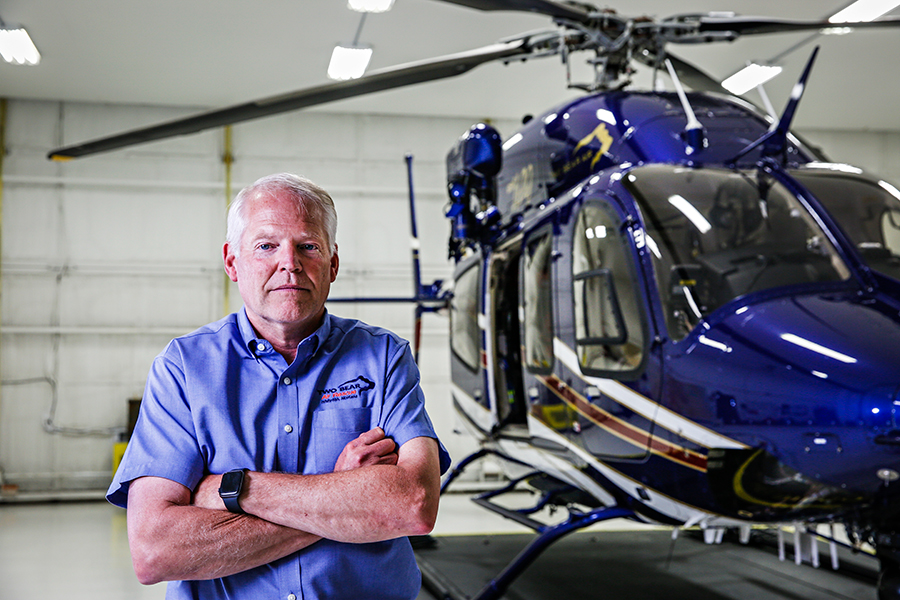Passion for the Mission
Two Bear Air Rescue’s Chief Pilot Jim Bob Pierce has flown dozens of life-or-death operations to rescue stranded adventurers, all with the memory of a deadly avalanche never far from his mind
By Andy Viano
There’s a day that Jim Bob Pierce sometimes thinks about when he pilots Two Bear Air Rescue’s Bell 429 helicopter skyward before swooping down to put an end to the worst day of someone’s life.
The day is New Year’s Eve 1993, and it remains one of the darkest Pierce has ever had.
Pierce grew up in Bigfork and is experienced in the wilds of Northwest Montana, but when he and 13 other snowmobilers went up Peters Ridge in the Swan Range more than two decades ago they were powerless against Mother Nature. A 350-foot-wide avalanche roared down the mountain that day and snuffed out five lives, including those of a Kalispell firefighter and a 7-year-old boy, and helped create a passion for his current work that Pierce brings with him on many a rescue mission.
“I know the helplessness or the hopelessness of wondering if somebody’s coming,” Pierce said. “Every time we have a rescue, especially an avalanche, it really hits home.”
Two Bear is the brainchild of Pierce, who serves as executive director and chief pilot, and bankrolled by Whitefish philanthropist Michael Goguen, who Pierce first cold-called years ago. Pierce had a modest vision to create a formalized search-and-rescue helicopter program in the Flathead Valley, and Goguen agreed to fund it, but only if the operation would be “world class.” The result is precisely that, with a sparkling home base at Glacier Park International Airport, a helicopter decked out with all the latest and greatest search-and-rescue technology, and a stable of rescuers that includes three pilots and 11 rear crew who are ready 24 hours a day to spring into action. Pierce said Two Bear can have a crew of three airborne within 40 minutes of receiving any call for their services, and because of Goguen’s multi-million dollar financial commitment, the entire operation is offered to the community at no taxpayer cost.
The Flathead County Sheriff’s Office and other local law enforcement agencies work closely with Two Bear, and the helicopter operation’s mission is simply to help whenever it might be helpful, something made easier because budgetary concerns never need to factor into a decision to fly or not.
“Somebody’s life shouldn’t be tied to the cost (of the rescue),” Pierce said. “I’ve always said that I’d rather go out for a bad reason or for no reason than to sit here, say ‘no’ and then find out it was for a good reason.”
Two Bear is approaching 700 total missions since 2014, and while the number of missions has actually been trending downward the last two years, Pierce and his colleagues aren’t getting complacent, and he hopes adventurers remember to do the same.
“Complacency, I think, is the biggest factor,” Pierce said. “People aren’t respecting, or thinking through, the ‘what if’ or ‘what am I going to do?’ if an accident happens.”
Accidents do happen, Pierce said, but plenty are avoidable, and he offered tips for anyone planning to venture outdoors this summer. Be prepared, know your ability, pay attention to your surroundings, tell someone where you’re going and take a light source, just in case Two Bear has to come look for you once the sun goes down.
In addition to the rescues on land and water, Two Bear assists local law enforcement in a non-rescue capacity and has recently been helping wildlife researchers track the movements of grizzly bears, a mission that also serves as a training tool for crew members.
Pierce himself became a pilot later in life, taking his first flight in 2006 at age 43, but in the years since he has poured himself into the craft. He can recount harrowing stories of dangerous rescues over the years but says even all these missions later he’s “never comfortable” when a search begins. And he said he takes heed of the same advice that he offers to recreationists when he takes off.
“The worst thing you can say in one of these situations is, ‘I’ve got this,’” Pierce said. “If you don’t appreciate what you’re doing and respect what you’re doing and, in some cases, fear what you’re doing, you probably shouldn’t be doing it. Complacency kills.”
Two Bear has had hundreds of successful extractions over the years, and Pierce said those successful missions even include ones where the team is ultimately removing a body for a grieving family.
“It’s not a matter of life and limb for that person anymore,” Pierce said. “But for the family, somebody’s waiting somewhere for that person to come home. For that reason, it’s really valuable to us.”
And of course Pierce knows as well as anyone what can cause those kinds of tragic endings. The avalanche on Peters Ridge in 1993 remains one of the deadliest in Montana history, and when the memory pings his brain as a flight takes off, he quiets it with a feeling of gratitude for the opportunity he and Two Bear Air Rescue have to serve their community.
“It makes you very passionate, in not just knowing what people are thinking or what they’re doing, but (what it’s like) being there at the scene,” he said. “And it makes you appreciative of someone like (Goguen) who puts it out there at no cost.”